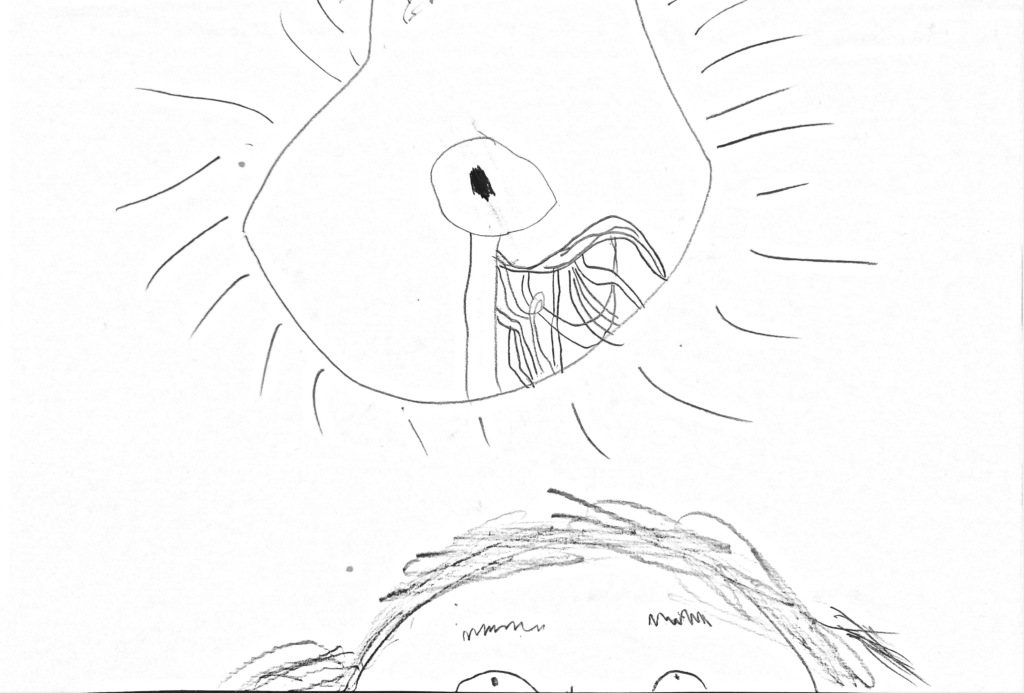Where next for place-based research?
by Sam Baars
23rd December 2021
I have this picture on my fridge: Ida drew it a few weeks ago when she was briefly fascinated by filament bulbs. It’s an image that’s greeted me every morning throughout December, and it’s encouraged me to identify the flashes of inspiration I’ve had this year, working alongside the CfEY team, and consolidate them into the bigger ideas I want to pursue in 2022.
It all started in a portacabin
My pet topic has always been the spatial side of youth and education. Neighbourhoods. Area-level inequalities. How young people make sense of where they live, or ‘place’. I’ve been exploring these themes for over a decade now. It all started when I worked with some construction students in Manchester at the start of my PhD. They will be in their late 20s now, and might still probably won’t remember the odd chap who visited each week with his video camera and tripod, to interview them about their neighbourhood and their hopes for the future.
A pioneering year
Fast forward, and 2021’s been a pioneering year at CfEY for exploring place-based questions in youth and education:
- I published a chapter on area-based inequalities in Young People on the Margins which gave me a chance to distil a decade of my own thinking and acknowledge all the greats whose ideas I’ve drawn on. I make the case for: talking about ‘types’ of area rather than more or less ‘deprived’ areas; focusing more on outer-urban areas, small towns and rural contexts rather than the big metropolitan centres; giving more space to young people’s understanding of their neighbourhoods, alongside the panoply of data-driven indices, metrics, classifications and typologies
- We worked with the Rothschild Foundation to map the youth context in Bucks in granular detail, and then went out into the field to speak to young people and community organisations to hear about their work, challenges and priorities. This was a new type of project for us, and a valuable opportunity to explore what it’s like for young people who fall through the cracks in an affluent county. We can’t wait to do follow-ups in other areas of the country
- Our evaluation of the Brighton Streets Project was another first for us; training youth workers to conduct walking interviews with young people in their neighbourhoods and mapping the data with participatory photography
- The Education Select Committee published its report on white working class pupils. I gave zoom evidence to the enquiry, and the report generated some genuinely decent media discussion. I took the chance to steer the debate away from the culture wars, and towards the need to focus on outer-urban neighbourhoods and ‘hard pressed’ areas, on national radio and telly
- Our work with the National Citizens Service on enriching education recovery highlighted the need to put structures in place to help schools make the most of the community assets on their doorstep, and also to address the variable density of community resources for educational enrichment in different parts of the country
Next steps
I want to build on this momentum in 2022, to keep CfEY at the forefront of pioneering place-based research on young people’s lives. Bringing together the insights from the work we’ve done this year, and the questions I’ve always wanted to explore but haven’t got round to, this is my back-of-an-envelope wish list of topics we want to delve into in the new year:
- Getting inside the black box: Area-based research and policy is dominated by a wealth of quantitative data, metrics, indices and maps which identify where outcomes are poor. Meanwhile, our understanding of how these poor outcomes are produced by area- and neighbourhood-level factors is woefully limited. We need to get our head around the mechanics. That would involve detailed fieldwork with young people in a handful of carefully selected case study sites, to explore the neighbourhood barriers and assets around them, and how these shape their hopes, expectations, decisions and outcomes
- Rebooting area-based policy: What can we learn from Opportunity Areas and other recent or current place-based improvement programmes for young people? We’ve been here so many times before with area-based initiatives: what can we realistically hope for them to achieve? Is there a better alternative? How can area typologies help existing, successful hyper-local initiatives port to other, similar areas of the country – maybe via the ‘families’ of schools within MATs? How can our collective knowledge best inform the government’s Levelling Up agenda?
- Shining a light on hidden cold spots: What’s it like growing up in an affluent county, but unable to access its opportunities and assets? What can we do about the transport barriers that face young people below driving age outside urban centres? How can remote and hybrid working be used to engage young people with more diverse (and non-local) labour market opportunities? These are key questions for local authorities, Local Enterprise Partnerships, local grant-making organisations and grassroots community groups – particularly in areas that don’t meet the standard deprivation-based threshold for intervention
We’re actively looking for partners to help us pursue these ideas – if you’re interested please get in touch.


Comments